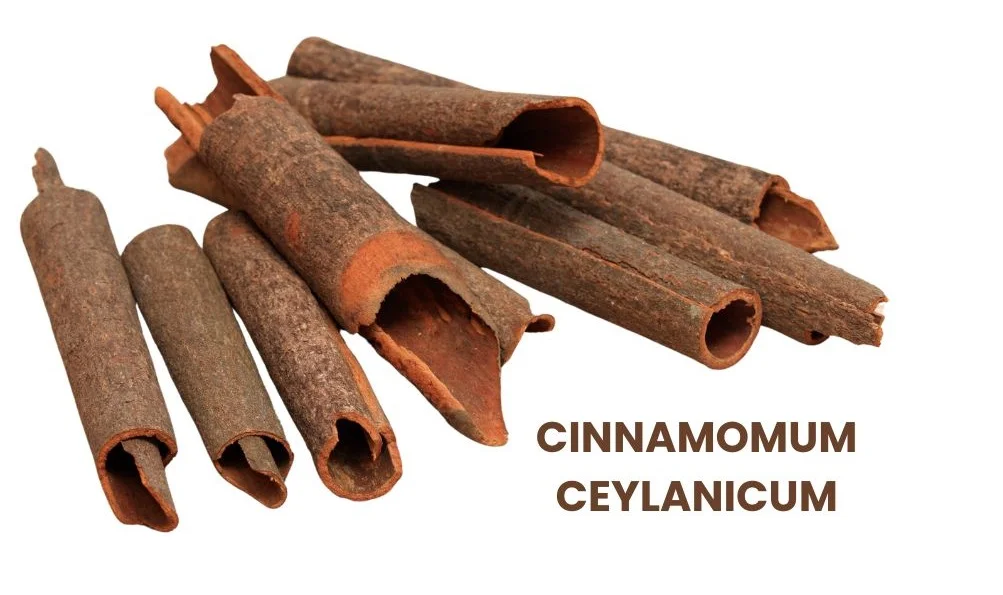Cinnamomum Ceylanicum, commonly known as cinnamon, is a powerful homeopathic remedy extracted from the bark of the cinnamon tree.
It has a rich history both as a spice and in traditional medicine for treating a variety of conditions.
In homeopathy, it is primarily used for hemorrhages, digestive disturbances, and specific conditions related to cancer where pain and foul-smelling discharges (fetor) are present.
The remedy is especially effective for patients with weak circulatory systems and conditions involving blood loss, such as postpartum haemorrhage or nosebleeds.

Table of Contents
ToggleSOURCE INFORMATION
Scientific Classification
- Kingdom: Plantae
- Clade: Angiosperms
- Order: Laurales
- Family: Lauraceae
- Genus: Cinnamomum
- Species: Cinnamomum ceylanicum
Cinnamomum ceylanicum is native to Sri Lanka (formerly Ceylon), where it has been used for centuries as a spice and medicinal herb.
Historically, cinnamon was highly prized in ancient Egypt, where it was used in embalming, perfumes, and medicine.
In the Middle Ages, it was a luxury item in Europe, often used to treat coughs, hoarseness, and sore throats.
DRUG PATHOGENESIS
- Cinnamomum works primarily on the circulatory and digestive systems.
- Its therapeutic action is focused on controlling hemorrhages and addressing symptoms caused by weakened circulation.
- The remedy has been clinically verified for conditions involving bleeding, pain, and digestive disturbances like flatulence and diarrhea.
PHYSICAL CONSTITUTION
- Suitable for individuals who are feeble or have weak circulatory systems.
- They may present with pale skin, fatigue, and a tendency to bleed easily.
- Often, these patients feel cold and weak, especially after minor exertion.
DIATHESIS
- Tends to favor patients with a hemorrhagic or asthenic (weak) diathesis, meaning they are prone to excessive bleeding, whether from the uterus, nose, or other internal organs.
TEMPERAMENT
- The patients are often lethargic, listless, and have a slow recovery after illness.
- They may have a general feeling of weakness and aversion to physical activity.
KEY CHARACTERISTICS
- Hemorrhages: The primary action of Cinnamomum is controlling bright red hemorrhages from various parts of the body, such as the nose, uterus, lungs (haemoptysis), and gastrointestinal tract.
- Postpartum Haemorrhage: Particularly effective for postpartum bleeding, especially if caused by physical overexertion.
- Flatulence and Diarrhea: Helpful in managing digestive disturbances in feeble patients who experience gas and diarrhea, often accompanied by a sense of weakness.
- Uterine Haemorrhage: Effective for uterine hemorrhages caused by overlifting or in the puerperal (post-childbirth) state.
- Cancer Symptoms: In cases where cancer is accompanied by pain and a foul odor, Cinnamomum can provide relief, particularly if the skin remains intact.
DETAILED ORGAN SYMPTOMS
- Head: May experience dizziness and weakness after bleeding episodes or physical exertion.
- Nose: Effective for nosebleeds, especially if bright red blood flows profusely with minimal trauma.
- Lungs: Used for hemoptysis, where bright red blood is coughed up from the lungs.
- Stomach and Bowels: Can alleviate flatulence, bloating, and diarrhea, especially in patients with weakened circulatory systems.
- Uterus: Cinnamomum is highly effective for treating uterine hemorrhages, particularly when caused by lifting or other physical exertion.
- It also addresses menorrhagia (heavy menstruation) and postpartum bleeding.
- Skin: Used as a disinfectant for wounds where there is no broken skin, preventing infections.
MODALITIES
- Worse: From physical exertion, lifting, and minor trauma.
- Better: From rest, lying down, and avoiding overexertion.
RELATIONSHIP WITH OTHER DRUGS
Compare
- Ipecacuanha (Ipecac): For hemorrhages and nausea.
- Silicea: For general weakness and slow recovery.
- Trillium: For uterine hemorrhages.
Antidote: Aconite may serve as an antidote for adverse reactions to Cinnamomum.
DOSE
- Hemorrhages: Use tincture to third potency for acute bleeding episodes.
- For postpartum haemorrhage and uterine bleeding, this remedy is highly effective in tincture form or lower potencies.
- Cancer Symptoms: In cases of cancer with pain and odour, a strong decoction of Cinnamomum (half a pint per day) is recommended.
- External Use: Oil of cinnamon is an excellent local disinfectant, often used in aqueous solution for cleansing and as a douche.
Frequently Asked Questions
Can Cinnamomum help with heavy periods?
- Yes, it is highly effective for heavy menstrual bleeding, especially when caused by physical overexertion or in the postpartum state.
How does Cinnamomum help with bleeding disorders?
- This remedy is particularly useful for hemorrhages where there is bright red blood, including nosebleeds, uterine bleeding, and bleeding from the lungs or gastrointestinal tract.
Is Cinnamomum useful for digestive issues?
- Yes, it helps relieve symptoms of flatulence, bloating, and diarrhea, particularly in individuals with weak circulation or who feel generally feeble.
Can it be used for cancer?
- In homeopathic practice, Cinnamomum is used in the later stages of cancer to alleviate symptoms like pain and foul odour, but it is not a cure for the disease itself.
Glossary of Difficult Words
- Haemoptysis: The act of coughing up blood from the lungs.
- Menorrhagia: Excessive or prolonged menstrual bleeding.
- Puerperal: Relating to the period following childbirth.
- Fetor: A strong, foul smell often associated with infection or decay.
- Decoction: A method of extraction by boiling herbs to obtain their active components.
- Asthenic: Weak, fatigued, or feeble.
This overview provides a thorough understanding of Cinnamomum Ceylanicum and its application in homeopathy for conditions involving bleeding, digestive disturbances, and specific cancer symptoms.
